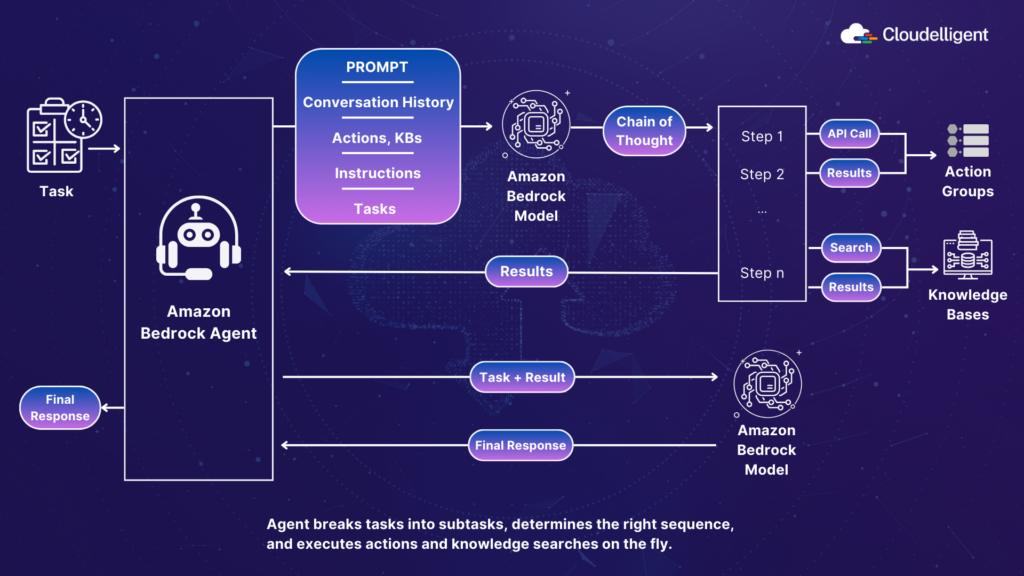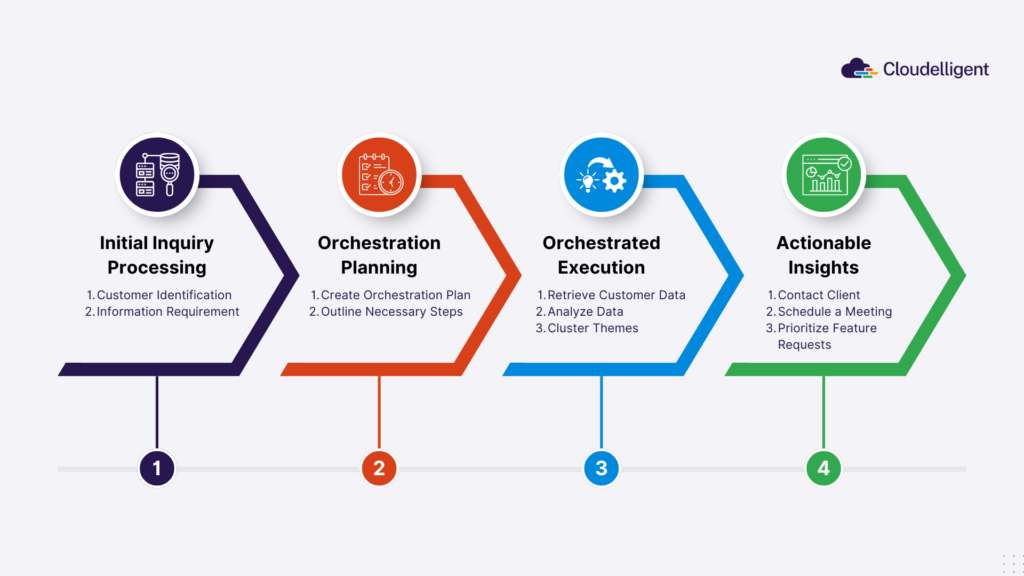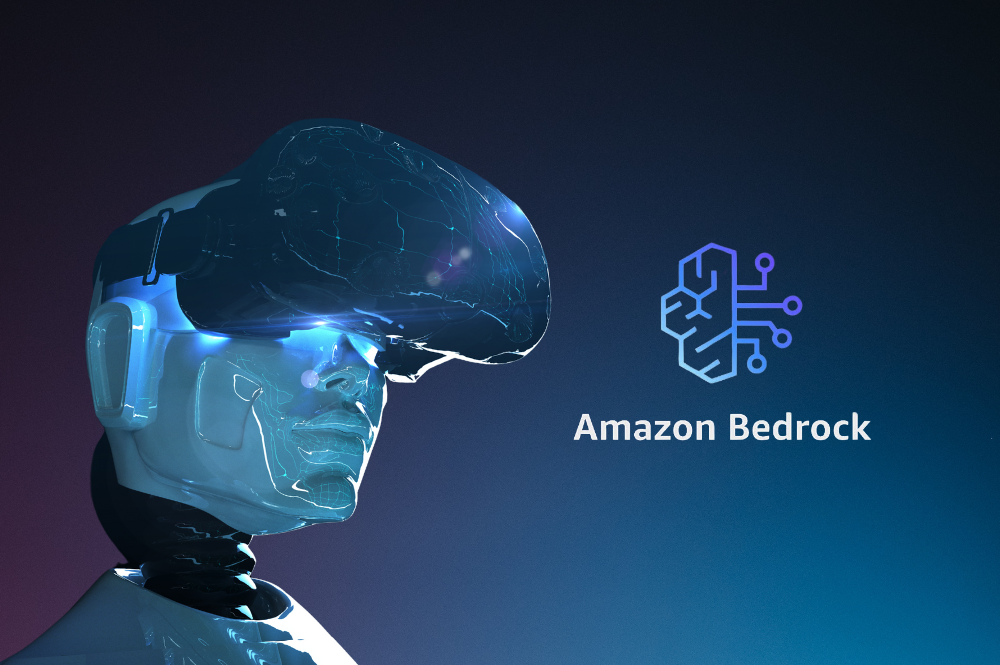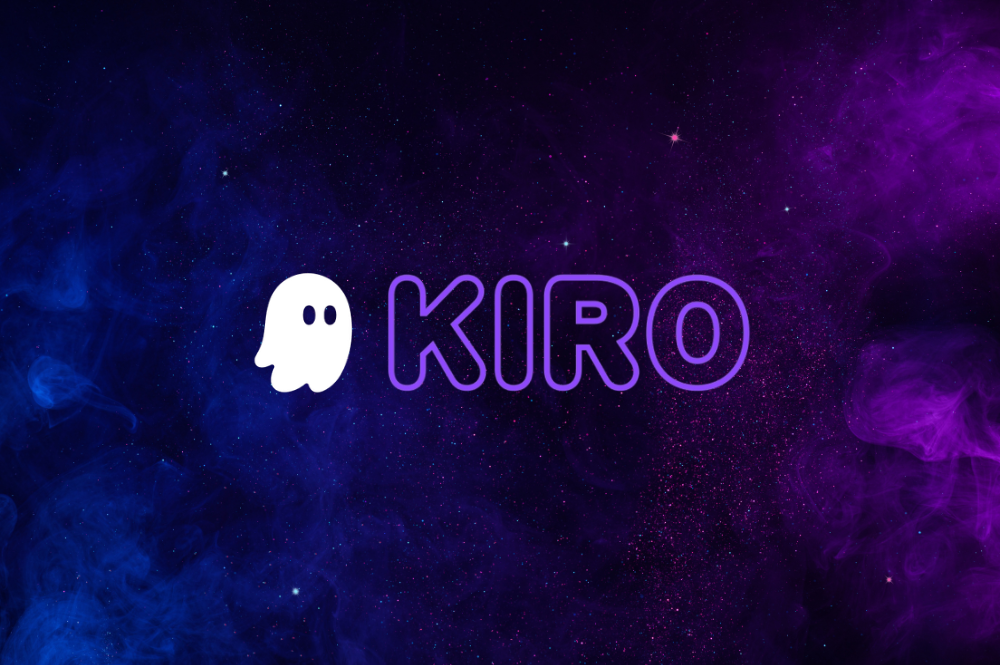Let’s be honest. We’ve all wished our computers could understand what we need and get it done. Not just follow pre-programmed instructions but actually figure things out, connect the dots, and take the necessary steps. We’ve interacted with AI assistants that answer questions, set reminders, and even generate amazing content. But what if AI could go beyond responding and actually act on our behalf?
That’s where Amazon Bedrock Agents make a real difference. These AI-powered agents don’t just provide answers. They take action, automate tasks, make decisions, and handle workflows so you don’t have to. Intelligent agents bridge the gap between simply interacting with AI and truly leveraging its power to streamline workflows and execute complex tasks without constant human intervention.
This shift from passive responders to proactive actors is precisely what makes Amazon Bedrock Agents so transformative, connecting powerful foundation models with real-world business applications. The rapid evolution of Generative AI has made robust, scalable, and secure implementations more critical than ever, especially when developing sophisticated AI applications. Amazon Bedrock Agents provide that fully managed environment, enabling organizations to do just that—without compromising security or scalability.
In this blog, we’ll dive deep into what makes Amazon Bedrock Agents a powerful tool for automation. We’ll explore their core features, how they drive intelligent workflows, and how businesses can leverage them to build AI-driven applications.
How Amazon Bedrock Agents Work Behind the Scenes
Amazon Bedrock Agents are more than just clever chatbots; they represent a fundamental change in how we interact with AI. These intelligent agents are the key to moving beyond passive responses to proactive actions and transform simple queries into tangible results. But how do they work? Let’s unpack the core components that make them so powerful:
- Foundation Model Reasoning: At its core, Amazon Bedrock Agents leverage the cognitive prowess of Foundation Models (FMs). These models provide the essential framework for understanding and processing the user’s natural language input. They can interpret complex requests, generate human-like responses, and maintain context seamlessly throughout the interaction.
- Developer-Defined Instructions: These instructions act as crucial guardrails, shaping the agent’s behavior and problem-solving approach. They provide the necessary context and constraints for interacting with various systems, ensuring alignment with business logic and security protocols.
- Retrieval Augmented Generation (RAG) Integration: Bedrock Agents seamlessly integrates with your company’s APIs and knowledge bases through RAG. This allows the agent to tap into your organization’s specific data and functionality, grounding its responses in real-world information and enabling it to perform actions within your existing infrastructure. This makes the agent not just intelligent, but useful.
Inside the Engine: Orchestrating Intelligent Workflows with Bedrock Agents

Figure 1: The Agent Orchestrating Complex Tasks
The orchestration workflow of a Bedrock Agent follows a sophisticated yet logical progression:
- Task Reception: The journey begins when the agent receives a user’s request, expressed in natural language. It’s the starting point for the agent’s intelligent processing.
- Planning Phase: Now, the agent’s underlying foundation model takes center stage. It analyzes the request and crafts a multi-step plan to achieve the desired outcome. This is where the agent’s reasoning abilities shine.
- Action Execution: With a plan in place, the agent systematically executes the necessary actions. This could involve anything from making API calls and querying knowledge bases to performing other critical operations.
- Result Synthesis: The agent doesn’t just execute; it learns. It collects and processes the results from each action, gathering the information needed to formulate a comprehensive response.
- Response Generation: Finally, the agent synthesizes all the information and crafts a coherent, relevant response that directly addresses the user’s original request.
This powerful workflow is underpinned by several key components:
- Agent Instructions: These are the foundational rules, providing the agent with clear guidelines for operation. They ensure alignment with business requirements and best practices, keeping the agent on track.
- Language Model (LLM): The LLM is the engine of understanding and planning. It empowers the agent to comprehend natural language requests and formulate intelligent, appropriate responses.
- APIs and Knowledge Bases: A robust set of tools, including APIs and knowledge bases, provides the agent with the means to execute tasks and access the information it needs. This is where the agent connects with your existing systems.
- Execution Trace: Transparency and debuggability are crucial. The execution trace capability provides detailed logs of the agent’s decision-making process and actions, allowing for easy monitoring and troubleshooting.
Features That Drive Intelligent Automation
What makes Amazon Bedrock Agents a true powerhouse for next-generation AI? They excel in several critical areas that make it particularly valuable for advanced applications.
- Intelligent Task Orchestration: One of its most impressive strengths is the ability to dissect and orchestrate complex, multi-step tasks. Faced with a challenging request, the agent intelligently constructs a logical plan of action. It figures out the necessary steps and determines the optimal order for execution. This planning prowess ensures that even the most intricate tasks are handled systematically and efficiently.
- Dynamic API Invocation: Another important capability is its dynamic API invocation. Instead of rigidly following pre-set paths, the agent intelligently decides which APIs to call and adapts seamlessly to different situations and evolving requirements. This dynamic approach makes it incredibly versatile and responsive.
- Chain-of-Thought Reasoning: Perhaps most remarkable is Bedrock Agents’ use of chain-of-thought reasoning for dynamic execution plan generation. This means the agent can adapt its approach based on the specific context of each request, mimicking how a human would analyze and solve a problem. It’s not just reacting; it’s thinking.
- Multi-Agent Collaboration: Building on this foundation, Amazon Bedrock takes intelligent task orchestration a step further with multi-agent collaboration. Imagine a complex business workflow, traditionally requiring multiple human specialists working together. Amazon Bedrock Agents can be designed to mimic this collaboration. A “supervisor agent” can break down the workflow into manageable steps, and then delegate tasks to specialized sub-agents, each an expert in its domain. These sub-agents work together seamlessly, communicating and sharing information to ensure precision and reliability. The end result is the automation of complex operational processes, freeing human teams from repetitive tasks and allowing them to focus on higher-value activities.
- Security First: Security is important, and Amazon Bedrock Agents doesn’t disappoint. It incorporates robust security measures via Guardrails for accessing sensitive company data, guaranteeing appropriate handling, and maintaining strict access controls throughout the entire execution process. Your data remains protected.
Amazon Bedrock Agents in Action: CRM with Intelligent Automation
We’ll dive into a Customer Relationship Management (CRM) use case to demonstrate how Amazon Bedrock Agents operate. This example shows their potential and provides a blueprint for similar solutions across industries.
Consider a scenario where an account manager needs to quickly understand a customer’s concerns and plan effective follow-up actions. Traditionally, this involves sifting through emails, support tickets, call logs, and other data sources, a time-consuming and often inefficient process. However, the specialist CRM Agent can transform this typically manual process into an efficient, automated workflow.
Let’s walk through a practical example of the agent in action.

Figure 2: Amazon Bedrock Agent’s Orchestration Execution
When asked, “What are Company A’s top concerns?”, the CRM Agent executes this workflow:
- Initial Query Processing: The agent analyzes the natural language query, identifying the customer and the required information.
- Orchestration Planning: Amazon Bedrock uses its foundation model to understand the request. Then it creates an orchestration plan, outlining the necessary steps: accessing CRM data, analyzing sentiment, identifying recurring themes and concerns, and prioritizing issues.
- Orchestrated Execution: The agent accesses the CRM system via APIs, retrieving relevant customer data, including emails, support tickets, and call transcripts. It then leverages the foundation model’s analytical capabilities to analyze the data, identify sentiment, and cluster common themes.
- Actionable Insights: The CRM agent compiles a summary of the top concerns, such as product performance issues, billing questions, or feature requests. It presents the data and generates actionable insights. For example, you can see such suggestions:
- “Contact Client A regarding recent product issues and offer a personalized solution.”
- “Schedule a meeting with Client B to discuss billing concerns and offer flexible payment options.”
- “Prioritize feature request X for the next product update based on feedback from multiple clients.
Adapting the Pattern for Diverse Applications
The principles demonstrated in the CRM example can be adapted for various industries and use cases. Here’s how similar patterns can be implemented in different contexts:
Healthcare
- Query: “What is Patient X’s treatment progress?”
- Workflow: Access medical records, analyze treatment history, summarize progress, and suggest next steps.
- Output: Treatment timeline, observations, recommendations.
SaaS Companies
- Query: “How is Customer Z’s product usage trending?”
- Workflow: Analyze usage metrics, review feature adoption, assess engagement patterns, and identify opportunities.
- Output: Usage analysis, churn risk indicators, expansion recommendations.
Financial Services
- Query: “What is Client Y’s portfolio risk profile?”
- Workflow: Retrieve investment data, analyze market conditions, assess risk factors, and generate recommendations.
- Output: Risk assessment, market impact analysis, adjustments.
Non-Profits
- Query: “What is the impact of Program A on our beneficiaries?”
- Workflow: Gather program metrics, analyze outcome data, evaluate resource utilization, and assess community impact.
- Output: Impact metrics, beneficiary success stories, and resource optimization suggestions.
Key Considerations for Building Your Own Intelligent Agents
When adapting this pattern to your industry, consider these key factors:
- Data Integration Strategy: Ensure your agent can access relevant data sources through well-defined APIs. In the CRM example, this meant connecting to customer interaction histories and preference data. For your industry, identify the critical data sources that need to be integrated.
- Context Management: Design your agent to maintain relevant context throughout the conversation. This might include industry-specific terminology, compliance requirements, or business rules unique to your sector.
- Response Formatting: Tailor the output format to match your industry’s needs. While the CRM example focused on customer concerns and follow-up actions, your implementation might need to emphasize several aspects such as compliance documentation or technical specifications.
Empower Your Applications to Think, Plan, and Act with Cloudelligent
At Cloudelligent, we specialize in building intelligent, secure, and scalable AI-driven solutions tailored to your business. Whether you’re looking to build applications with multi-step business processes, enhance customer experiences, or seamlessly integrate Generative AI, our team of experts can help you maximize the potential of Amazon Bedrock Agents. We’ll work with you to define your specific needs and develop a customized solution that delivers real business value.
Explore the Potential of Amazon Bedrock Agents
Ready to build smarter applications that transform your business? Schedule a Free Cloud AI and Machine Learning Consultation with Cloudelligent today to discuss your Generative AI strategy!










